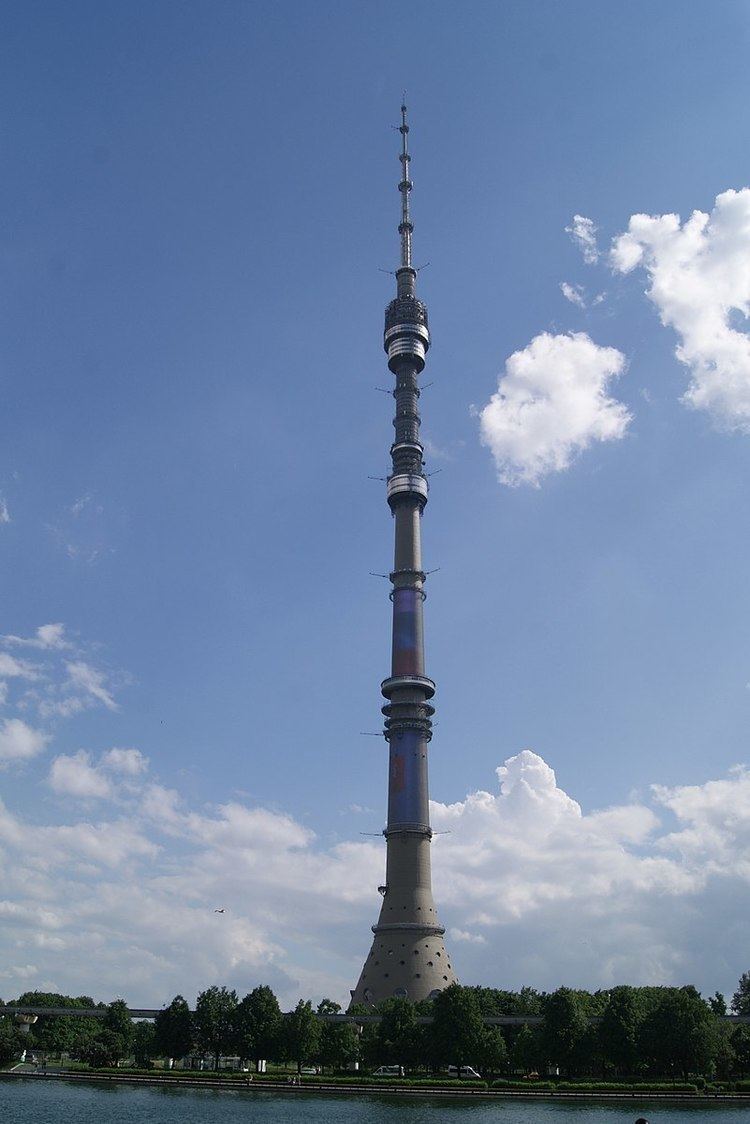Status Complete Construction started 1963 Opened 1967 | Location Moscow, Russia Height 540 m | |
 | ||
Type Observation, telecommunications, tourism Address pr-d Dubovoy Roshchi, 15, Moskva, Russia, 127427 Hours Open today · 10AM–9PMMonday10AM–9PMTuesday10AM–9PMWednesday10AM–9PMThursday10AM–9PMFriday10AM–9PMSaturday10AM–9PMSunday10AM–9PMSuggest an edit Similar Ostankino Palace, VDNKh, CN Tower, Shukhov Tower, Saint Basil's Cathedral | ||
Ostankino Tower (Russian: Останкинская телебашня, Ostankinskaya telebashnya) is a television and radio tower in Moscow, Russia, owned by the Moscow branch of unitary enterprise Russian TV and Radio Broadcasting Network. Standing 540.1 metres (1,772 ft) tall, Ostankino was designed by Nikolai Nikitin. It is currently the tallest freestanding structure in Europe and 11th tallest in the world. The tower was the first free-standing structure to exceed 500 m (1,600 ft) in height. Ostankino was built to mark the 50th anniversary of the October Revolution. It is named after the Ostankino district of Moscow in which it is located.
Contents
Construction began in 1963 and was completed in 1967. Extensive use of prestressed concrete resulted in a simple and sturdy structure that was a masterpiece of Soviet engineering in the time period it was built. It surpassed the Empire State Building to become the tallest free-standing structure in the world. It held this record for nine years until the CN Tower was completed in Toronto, Canada in 1976, which surpassed its height by 13 metres (43 ft). The Ostankino Tower remained the second-tallest structure in the world for another 31 years until the Burj Khalifa surpassed both it and the CN Tower in height in 2007. The Ostankino Tower has remained the tallest structure in Europe for 49 years.
A 1994 plan to increase the tower's height to 561 metres by adding an antenna was not implemented for lack of funding.
1 over ostankino tower personal quadcopter altitude record
Incidents and accidents
The tower caught fire on 27 August 2000, killing four people. Three firefighters died in the attempt to extinguish the fire, and one lift operator died when her elevator cabin crashed to the ground level due to the fire. In addition, television and radio signals were disrupted around Moscow. The fire broke out at a height of about 458 m (1,502.6 ft), or approximately 98 metres (322 ft) above the observation platform and the Seventh Heaven restaurant, after a short-circuit in wiring belonging to a paging company. The fire necessitated an evacuation of all visitors and staff from those locations. According to Russian news agencies, the evacuation was complete 90 minutes after the start of the fire. The loss was substantial due to the age and poor maintenance of the electronic equipment, much of which was installed in the 1960s. In addition, the tower had become increasingly packed with equipment.
The failure of the fire suppression systems allowed the fire to destroy most of the tower's interior. Although more than 300 firefighters and other emergency workers were called in, firemen were forced to haul heavy equipment, including chemical fire extinguishers, by hand up the tower to halt the fire. Temporary firewalls of asbestos placed 70 metres (230 ft) up stopped further spread. The fire knocked out virtually all television broadcasts in Moscow and the surrounding regions. The only television station unaffected was the private NTV station, but the government decreed that state channels took priority, and as such, the RTR TV channel began transmitting to several Moscow districts.
The fire caused the tower's upper spire to tilt slightly, triggering fears the tower might collapse. Subsequent inspection determined that although the structure sustained heavy damage, the tower was not in danger of collapse. Efforts began immediately to rebuild the tower, which proved to be a long and expensive task.
The fire was the third disaster in Russia in a month, following an explosion in a Moscow underground passage that killed 12 people and the sinking of submarine Kursk in the Barents Sea, in which 118 died. Russian President Vladimir Putin stated that "This latest accident shows the shape of our vital installations and the overall state of our country. We should not fail to see major problems in the country behind this accident, and we should not forget the economy. Whether or not such accidents happen again in the future will depend on how we work in this vital direction."
On 1 July 2004, Austrian BASE jumper Christina Grubelnik struck the tower during her descent, receiving a concussion and losing consciousness. Her parachute snagged on a lower-level service platform and she was rescued by Russian emergency services.
On 25 March 2005 the first new elevators since the August 2000 fire, made by the German company ThyssenKrupp, were tested and put into service. The new elevators travel at a speed of 6 metres per second (20 ft/s).
On 25 May 2007, the Ostankino again caught fire, though it was less serious than the 2000 fire and was isolated to a platform on the outside of the tower. All people inside the tower were evacuated and the fire was successfully extinguished, with no casualties.
In April 2009, the observation platform reopened, but the Seventh Heaven restaurant has remained closed since the accident.
